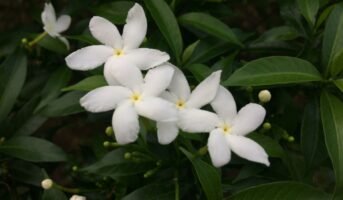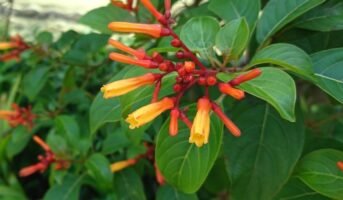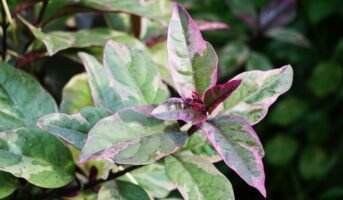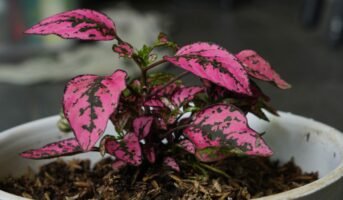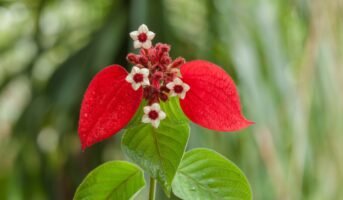Calliandra Haematocephala, also known as Red Powder Puff, is a fast-growing shrub that not only has the potential to become quite tall but also can spread quite far. You can trim it down to a smaller size if that’s what you want. It is interesting to note that the leaves turn inward at night.
Butterflies and hummingbirds are drawn to the Calliandra haematocephala flower from November until April when it is available. This large shrub can be grown indoors if it is trimmed and grown in a pot, but it will do much better if it can be grown outside in a warm climate.

Source: Pinterest
Calliandra Haematocephala: Key facts
| Common name | Red powder puff |
| Botanical name | Calliandra haematocephala |
| Family | Fabaceae |
| Height | 6 to 13 ft |
| Sunlight | Full sun |
| Flowering time | April to August |
| Soil | Well drained |
Calliandra Haematocephala: Features
Calliandra haematocephala, sometimes known as a red powder puff, is a native Bolivian evergreen shrub or small tree. It was previously classified as a legume or pea but has lately been moved to the mimosa family. In its native habitat, it normally attains a height of 10 to 15 feet and is a highly popular flowering shrub in central and southern Florida, where it may live year-round in the ground.
Copper-pink pinnately complex leaves (5-10 leaflets per pinna) develop to a dark green hue. Flower buds, like raspberries, unfurl into hemispherical red powder puff flower heads (up to 3 inches in diameter), including masses of crimson stamens. Blooms predominantly in autumn and winter, but isolated blooms may occur at other times of the year. There are variations in bloom colour, including pink and white varieties.
Calliandra Haematocephala: Propagation
How to grow from seeds?
The pods from which the seeds of a Calliandra plant are dispersed resemble those of the snow pea. Wait until the pod has developed enough on the plant to open.
Wrapping the pods in a pouch or cloth to collect the seeds is helpful, but this is rarely an issue when growing a large number of plants at once because they fruit so heavily.
Soak the seeds for a day in warm water. Plant the seeds in a soil mixture and water them regularly, but not so much that the soil becomes soggy. After 10-20 days, sprouting ought to start happening.
How to grow from cuttings?
You can also easily spread your Calliandra by making cuttings. Remove stems that are one foot (30 cm) or one yard (one metre) in length, depending on the size of the plant. Longer stems grow less, but when they do, they grow more quickly.
To make room for new growth, cut off all but the top few pairs of leaves carefully. Put them in water (glass works well for smaller ones, while a cut-up gallon jug works well for the larger ones) and replace the water every three days. You can also plant them in a pot of a soil mixture that drains well. If you have access to the rooting hormone, use it.
When the plant has established roots, you can move it to a larger container or the garden. Within two weeks, cuttings begin to root, and after another month and a half, they are ready to be transplanted. Leave the container close to where it will be planted for a week before you dig it up and plant it. This will reduce the chance of transplant shock.
Spreading your Calliandra is also a breeze because you can propagate it through cuttings. The general rule is to cut off any stems that are longer than a foot (30 cm) from the ground. The longer stems won’t sprout as often, but they’ll spread rapidly when they do. Reduce the number of leaves to just the top few pairs to make room for new growth. Carefully sever the ends.
See also: 21 best flowers for your garden
Calliandra Haematocephala: Maintaining
Watering and fertilising
When spring arrives, you should begin providing the plant with consistent watering. Reduce the frequency of watering as the temperature drops in autumn. Once mature, powder puff plants are drought resistant. Apply a balanced granular or liquid fertiliser during the growing season when the weather begins to warm up in the spring. In the winter, fertiliser is unnecessary.
Transplanting and soil
Plant in regular soil that drains well, then amend it with peat moss, leaf mould, or compost to enhance drainage and the soil’s overall quality.
Every spring, it’s time to repot your plants. Keep to the same advice for soil. Powder puffs should only be repotted into larger containers once they have outgrown their current ones.
Pest and diseases
It’s common for aphids and mealybugs to attack Calliandra plants. When there is new growth, this occurs more frequently.
Regular inspections of the plant for these pests are essential. The elimination of a small number of pests is much less difficult than the elimination of a large infestation. If you only have a few aphids or mealybugs, you can kill them with a water spray. The use of an insecticide like neem is often necessary in the face of grave dangers.
Grooming
Plants often need to be pruned in order to keep their size under control. Although it has a potential height of six feet, it is usually kept pruned to a height of just a few when used as a hedge. Pinch or prune the branches as necessary in the spring. Plants can be multiplied through cuttings from pruning.

Source: Pinterest
See also: What is Hibiscus and how to grow it in your home?
Calliandra Haematocephala: Uses
Calliandra haematocephala is an excellent permaculture plant. Not only is it a gorgeous screen plant, but it is also incredibly functional. It is a legume, pioneer plant, chop-and-drop mulch, additional materials for composting, and permaculture animal feed.
Medicinal benefits
Some of the medicinal benefits include:
- Relief from haemorrhoids, the prevention of infection, reduced inflammation, and the elimination of seizures.
- Modulation of the immune system for ulcer prevention.
- The flower’s decoction serves as a tonic and blood purifier.
Toxicity
Flowers and seeds are poisonous if consumed.
FAQs
Is Calliandra haematocephala a type of bush?
Yes, Calliandra haematocephala is a type of bush.
Is it possible to propagate a powder puff tree?
The cuttings root quickly, making propagation relatively simple.
Housing News Desk is the news desk of leading online real estate portal, Housing.com. Housing News Desk focuses on a variety of topics such as real estate laws, taxes, current news, property trends, home loans, rentals, décor, green homes, home improvement, etc. The main objective of the news desk, is to cover the real estate sector from the perspective of providing information that is useful to the end-user.
Facebook: https://www.facebook.com/housing.com/
Twitter: https://twitter.com/Housing
Email: [email protected]

